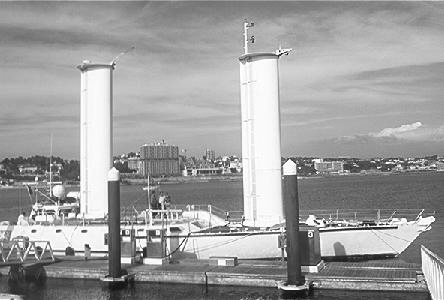Geoff wrote:Thu Nov 03, 2011 9:11 am Article from the Telegraph Shipping should turn to sail to cut carbon
Has a picture of the Cutty Sark under sail
Bunting Tosser wrote:Thu Nov 03, 2011 10:21 am Considering the height that containers are now stacked on deck, and the way a sailing ship heels over, how safe/viable would it be?
I recall that my father spoke of a ship with rotary sails ??? I couldn't follow the principle at the time. I have now read:
http://en.wikipedia.org/wiki/Flettner_ship
and can say that I still have no idea.
I guess that such a ship would be more "stable" and could accept high(er) loads on deck.
Perhaps.
Randi wrote:Thu Nov 03, 2011 12:09 pm Interesting article.
I had read about the significant savings from reducing speeds a couple of years ago - for airplanes too.
A towing kite, while perhaps more sensitive to wind direction :-\, might not interfere with containers too much.
Bunting Tosser wrote:Thu Nov 03, 2011 5:48 pm And then there is always the thoroughly modern manner:
http://www.bbc.co.uk/news/uk-scotland-s ... s-15568999
Janet Jaguar wrote:Thu Nov 03, 2011 6:26 pm My first thought was my logs on the old sloop Torch. She had three masts and actively used a full set of sails for her primary motive power when the winds were favorable - and in fact traveled significantly faster than when using engine only. The combination works very well, allowing movement on calm days while saving a great deal of fuel.
My second thought was the documentary I saw on Jacques Cousteau's ship Alcyone sailed by his son. The engines operated fans drawing wind in and for angling the rotors in the stack, the wind on the rotors provided the propulsion. And I'm quoting, because I'm not enough of an engineer to fully understand it. But only 2 working ships have been studied for fuel savings:My third thought was the top-heavy SS Eastland. There is a memorial plaque at her dock in Chicago's Loop honoring the deaths of the 844 passengers and crew who drowned when she rolled over while still moored to the dock in 1915, and my grandparents told me stories of their memories of the horror that accident produced in the entire city. This is a very serious danger.The Alcyone reported a 1/3 fuel savings, and a larger commercial vessel had a 15% increase in fuel efficiency over a three year study (see "external links" for references). The system bears similarities with Anton Flettner's Rotorschiff, a different design based on the Magnus effect.
Still, there has to be a way to make efficient and safe hybrid ships that let wind reduce their carbon footprint. If we can do it with cars, we can do it with ships. And the bottom of Bunts' Wiki article also suggests Windmill ships: standard morotized propulsion driven by electricity generated partially or entirely by a windmill. The current direction of the wind is irrelevant to the direction of travel, and would tie in with Bunts' electric ferries.
The SS Eastland:
The SS Alcyone:

dorbel wrote:Fri Nov 04, 2011 10:52 pm Flettner rotors were first fitted to an experimental ship, the German "Barbara" in the 1920's. They are tall lightweight metal towers and they are rotated at high speed when there is some wind to take advantage of the Magnus effect. This is the effect whereby a sphere (or in this case a cylinder) rotating in a fluid (or in this case air) sets up currents around itself as it moves that stimulate a pressure drop on the leading edge and a pressure increase on the trailing edge. This provides motive power in the same way as a sail or an aircraft wing and is intended to supplement the propulsion provided by the screw, giving greater speed and/or improved fuel consumption. They don't affect the stability of the vessel and they do work. It is important to vary the speed of the rotors in relation to the wind speed to maximise the effect, so modern computer controls should make them more efficient than those of 80 years ago! Given high fuel costs now it seems likely that the expense of fitting these might well pay for itself, although not perhaps on container vessels that have no deck space whatsoever!
The advantage of the rotors over the more obvious sails is that they provide propulsion regardless of the direction of the wind.
